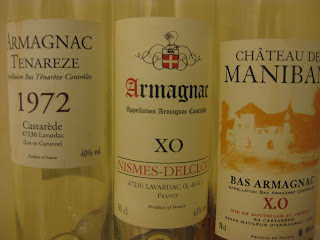Armagnac from the Castarede family

For my second blog entry I look at the brandy Armagnac from France and here I focus on the Castarede family. The Castarede family in Armagnac in France has been dealing with Armagnac since 1832. What is Armagnac? Armagnac is a brandy produced in the Armagnac region. It is the oldest brandy in France but the production is much less volume than Cognac, like 30 times less. Also a another difference to Cognac is that in Armagnac a lot is being sold as vintages. I will talk much more about how Armagnac is produced in later blog posts. The Castarede family has four different brands of which I have tried three. First up is the Castarede from 1972. This vintage is made of 100% of the grape Folly Blanche. It was bottled on the third of January 2012. That means that this Armagnac is 40 years old. In the nose I get Marzipan and dark fruits. In the taste there is dark fruits, walnuts, Christmas cake and some spices. The aftertaste is long and spicy. An excellent vintage Armagnac. Next up is ...
